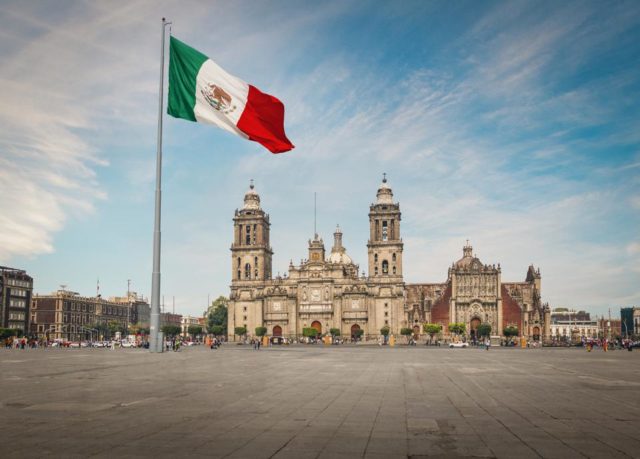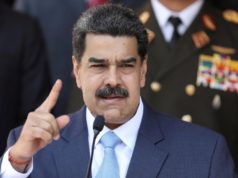Editor's Note: Our closest neighbor, and biggest trading partner is foundering: Mexico is in deep economic recession; flooded with crime and domestic insecurity; and facing rising political weakness in the government. In some respects, the bilateral relationship with the U.S. is strong, especially with regard to cooperation on illegal immigration. Now the U.S. needs to decide what to do before China makes inroads with our troubled neighbor to the South.
With 128 million people and GDP of $1.26 trillion, Mexico is strongly connected to the United States through geography, commerce, and family. What happens in Mexico directly affects the security and prosperity of the United States, and vice versa. Mexico, not China, is the United States’ largest trading partner, with $614 billion in bilateral commerce in 2019. That exchange is reinforced by the United States-Mexico-Canada-Agreement (USMCA), which feeds and is fed by enormous U.S. investment – $101 billion in 2019. The performance of the Mexican economy, local conditions, and the effectiveness of its governance affects American jobs, investment, security, and lives.
Americans are victimized by activities related to illegal drugs, including the movement of cocaine, the production of opioids and synthetics, and distribution of fentanyl from China, Mexico-based drug gangs and territory, just as Mexicans are victimized by weapons illegally smuggled into the country from the United States. The United States depends substantially on the efforts by and cooperation with the Mexican military and law enforcement to help combat narcotraffickers and organized crime.
Mexican cooperation is critical in U.S. efforts to manage the flood of Latin American would-be immigrants seeking to enter the U.S. Currently, Mexico hosts asylum applicants and is using a new national guard force to intercept migrants.
Geopolitically, as China increasingly poses a direct challenge to the United States in Latin America, having a friendly, stable Mexico next door is a strategic necessity.
But amid the global COVID-19 pandemic, Mexico is locked in disastrous, mutually reinforcing health, economic, and security crises. At this moment it is strongly in the interest of the United States to be a good neighbor.
The Pandemic
By November 1, Mexico had reported 968,000 COVID-19 cases, with 95,000 deaths. In Latin America, only Brazil had higher rates. Mexico’s response was shaped by President Andres Manuel Lopez Obrador’s (AMLO) hesitation to enact strict quarantine measures in the first months of the crisis; by a large informal sector (an estimated 60 percent of the economy) that needs to interact daily to earn money to survive; and by small businesses that couldn’t stay closed for long.
By one estimate, 922,000 jobs were lost, 73 percent of which are not expected to return. This in a country with a 40 percent poverty rate in a good year. Mexico’s longer-term economic prospects are also damaged. The U.S., as Mexico’s principal external market and investor, while rebounding at an extraordinary rate, still may contract as much as 4 percent in 2020. The Mexican prospect for rebounding from COVID-19 is hampered by AMLO’s restrictions on private investment in the electricity and petroleum sectors, and policies that increase business uncertainty and reduce foreign investment.
The pandemic has exacerbated a mounting fiscal crisis in Mexico despite AMLO’s commitment to austerity. It has reduced revenues from internal economic activities and exports while forcing the federal government to increase spending, including 3 billion pesos ($135 million) in credits for impacted citizens.
Low international oil prices and internal inefficiencies have turned Mexico’s national oil company, PEMEX, into a revenue drain on the national economy rather than a producer, taking on $2 billion in debt in the second quarter of 2020. In June 2020, the World Bank extended Mexico a $1 billion credit line to address the crisis. Mexico’s public debt is expected to leap from 45 percent to 60 percent this year. With hundreds of thousands of businesses permanently shuttered, and a crippled financial system, Mexico arguably faces a lost decade of economic growth.
Mexico’s Security Crisis
The country faces an escalating security crisis, with the government’s ability to respond undercut by the AMLO administration’s major reorganization of the security sector. Even before AMLO took office in December 2018, competition between an array of criminal cartels, affiliated gangs, and other groups was spiraling out of control. In 2019, Mexico recorded a record number of homicides, 34,582. An additional 18,000 Mexicans were killed in the first quarter of 2020, putting the country on track to break the new record, before the economic shutdown temporarily suppressed street crime. Despite the shutdown, high-profile crimes, such as the June attempt to assassinate Public Security Minister of Mexico City (CDMX) Omar García Harfuch in the upscale, protected Mexico City neighborhood of Lomas de Chapultepec, illustrate criminal boldness. Indeed, the attack came shortly after the first murder of a federal judge, Uriel Villegas Ortiz, in five years.
Even crime in previously safe maritime areas is re-emerging. In 2019, there were 20 registered incidents in the Gulf of Campeche alone.
As violence has increased, Mexico’s largest criminal groups, including the Jalisco Nuevo Generacion (CING) and Sinaloa cartels, have demonstrated their ability and willingness to defy the Mexican state. CJNG is now a presence in over half of Mexican territory, including the northern border region on both coasts.
Inter-cartel dynamics have been significantly affected by the pandemic. The Chinese government’s suspension of travel from Wuhan in early 2020 to control the COVID-19 outbreak also cut the supply of fentanyl moving from Wuhan to Mexico to the U.S. And while border closings interrupted the cartels’ ability to smuggle narcotics or traffic people, they found ways around laws. The Sinaloa Cartel responded to the interrupted supply of fentanyl through workarounds in production of synthetic drugs, and by procuring submarines for transport.
The pandemic has arguably helped the cartels consolidate control over territory and people. In April, AMLO criticized Sinaloa and the other cartels for distributing care packages to the hungry on the grounds that feeding people builds leverage over vulnerable communities.
In the medium term, the risk is that criminal violence, fueled by an expanding mass of desperate people and competition between opportunistic criminal groups, on top of security forces distracted by reorganization and the demands of supporting the national COVID-19 response, threatens to further erode law and order in Mexico.
The Security Sector Response
The response of Mexico’s military, law enforcement, and intelligence apparatuses to expanding security challenges has been hampered by significant, ill-timed, and arguably counterproductive reorganizations, including the move of the federal police from the interior ministry, followed by its plan to abolish the institution completely and replace it with a new 100,000-person national guard. The latter, although nominally under civilian control, draws a significant amount of its manpower and leadership from the Mexican army and navy. As the federal police have been disassembled and its resources diverted to the national guard, the transition has consumed considerable attention from leaders, generated confusion, and damaged morale within the organizations involved. A significant proportion of Mexico’s federal police officers have chosen to resign rather than transfer.
Mexico activated its national system for incident management for a public health emergency and brought the military in to support the national response. While such activities have placed the armed forces in a favorable light, they also have strained both the army and navy as institutions. Indeed, while supporting the nation’s response to the COVID-19 pandemic continues to be the priority mission, the current government has also made it responsible for a broad range of other tasks.
Political Chaos and Drift
Internally, political winds in Mexico have shifted since December 2018, when MORENA, AMLO’s political movement, won a supermajority in the Mexican Congress, and six governorships. On July 16, 2000, 30 Mexican intellectuals wrote a letter criticizing what they call a move toward authoritarianism, and the government’s “suicidal austerity” in response to the COVID-19 crisis. There are indications of internal frustration and division within AMLO’s cabinet. Three secretaries have resigned so far. MORENA is divided.
Mexico’s deteriorating situation threatens to impact the United States in multiple ways. Last April, the U.S. sought to convince AMLO to reopen factories tied to production in the U.S., because the shuttering affected American supply chains and investors. A collapse of the Mexican economy could send millions of desperate Mexicans to the border, seeking to immigrate. The deteriorating security situation could increase the flow of lethal drugs to the United States while expanding violence. Increasing political chaos encourages the more radical tendencies of AMLO and benefits advocates of leftist policy. A more radicalized Mexican government could undercut Mexico’s security and economic cooperation with the United States, and would likely deepen their opposition to U.S. policy on regional issues.
China’s Advance
Deepening crises in Mexican add to the risk of China expanding its position there. Mexico and China have acknowledged each other as “strategic partners” since 2003, but the relationship has been limited by Mexican integration with the U.S. market due to the NAFTA framework; a Mexican economic structure which competes with China more than compliments it; a class of business and political elites that view China with distrust as a competitor; conservative Mexican governments which have preferred a relationship with the United States; and, reciprocally, a Chinese government skeptical of Mexican intentions and worried about alarming the United States by courting Mexico aggressively. Nevertheless, the relationship is growing, and current crises create incentives for both nations to expand their commercial, political, and security relationships, which is not in the U.S. interest.
By contrast to China’s cautious dealings with Mexico under the administrations of Felipe Calderon and Enrique Pena Nieto, President Xi Jinping arguably recognizes that the present administration is more ideologically receptive to dealing with China as an alternative to the United States.
While China’s economic presence in Mexico is limited, it is larger than commonly known. A long list of China’s leading companies are lodged in Mexico, presently at work on large contracts in logistics, ports, manufacturing, petroleum, auto parts, mining, (including in Mexico’s lithium deposits), as well as electricity generation and transmission, and solar and wind power. Huawei and ZTE are significant sellers of smartphones and other equipment and infrastructure providers for Mexico’s principal telecommunications companies. The rideshare company Didi has made Mexico its target market in Latin America. China-based banks such ICBC and the Bank of China also operate there.
China operates five Confucius Institutes for the advancement of Chinese language and culture in Mexico. Hundreds of Mexican undergraduate and graduate students regularly study in China on scholarships, while Mexican reporters, think tank professionals, and others are hosted on all-expenses-paid trips by the Chinese government.
China has attempted to insinuate itself into Mexico’s oil industry with offers of investments and loans to PEMEX. Elsewhere, including Brazil, this move has made China a full partner with the host country – which cannot pay back such loans. It remains to be seen what AMLO will do. The same gambit is in play in the electricity industry, where China wishes to pursue a role in building and financing new plants, to increase electric generation.
Despite AMLO’s ongoing interest in a positive relationship with the United States, his warm tone toward China was on display at the 17th China-Mexico Bilateral consultation in June.
As of July, the Chinese government had sent 23 flights with Covid-19 related medical goods to Mexico, purchased by (not donated to) the Mexican government. By the end of March, the country had purchased 11.5 million KN95 masks, 16.1 million surgical masks, and 550,000 gloves from a Chinese company. China has further offered a $1 billion line of credit to Mexico in a self-serving gesture to facilitate the country’s purchase of a Covid-19 vaccine, presumably to be developed by China.
Recommendations
It is in the United States’ strategic interest to support Mexico in the present time of crisis, with respect and generosity. It is critical to treat Mexico as a neighbor in need of collaboration to help it weather current conditions, and not as a failed state which requires charity, tutelage, or the imposition of order.
In the economic sphere, the United States should fully leverage Mexico’s geographic proximity and economic integration with the U.S. economy, as strengthened by the new USMCA treaty, to create incentives for American companies to use Mexico for “near-shoring” activities, as they diversify away from activities in China, and focus on opportunities to use the resources of the Development Finance Corporation and the America Crece program, avoiding threats of sanctions over differences on trade and immigration issues.
In bilateral affairs, the U.S. should explore commitments to encourage Mexican private sector growth, offering concrete steps toward expanded U.S. investment and, crucially, a shift in posture on immigration.
The U.S. can expand cooperation with Mexico on security matters including arms smuggling, and the reduction of narcotics demand in both countries, providing training, material, intelligence, and other support for their new national guard, while working with Mexico’s military. The United States should apply less pressure to use the guard for immigration-control, in exchange for concrete demonstration of willingness to work together to take on the cartels and other criminal groups threatening Mexico’s sovereignty and the security of both countries.
The dilemmas confronting Mexico are grave. The choices available to both nations to address these problems are neither easy nor cheap. But the cost of inaction is unacceptable.
R. Evan Ellis, Ph.D., is a non-resident senior associate with the Americas Program at Center for Strategic and International Studies. A version of this article appeared at CSIS earlier this year.






